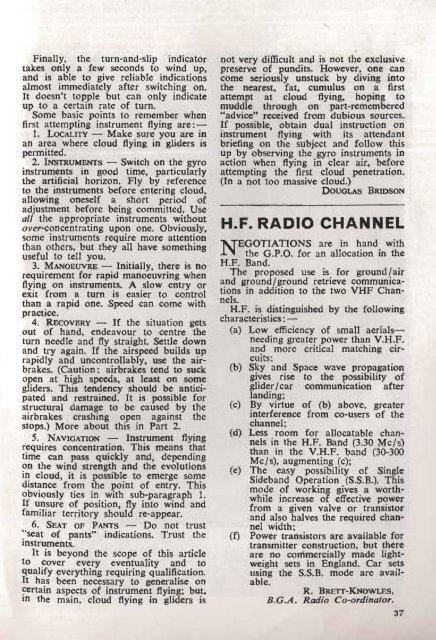Volume 16 No 1 Feb 1965.pdf - Lakes Gliding Club
Volume 16 No 1 Feb 1965.pdf - Lakes Gliding Club
Volume 16 No 1 Feb 1965.pdf - Lakes Gliding Club
- No tags were found...
Create successful ePaper yourself
Turn your PDF publications into a flip-book with our unique Google optimized e-Paper software.
Finally, the turn-and-slip indicatortakes only a few seconds to wind up,and is able to give reliable indicationsalmost immediately after switching on.It doesn't topple but can only indicateup to a certain rate of turn.Some basic points to remember whenfirst attempting instrument flying are:1. LOC~LlTY - Make sure you are inan area where cloud flying in gliders ispermitted.2. INSTRUMENTS - Switch on the gywinstruments in good time; particularlytlte artjficial horizon. Fly by referenceto the insttum"nts before enterjng cloud,allowing ,oneself a short period ofadjustment before being committed. Useall the appropriate instruments withoutover-concentrating upon one. Obviously,some instruments require more attentionthan others, but they all have somethinguseful to tell you.3. MANOEUVRE - rnitially, there is norequirement for rapid manoeuvring whenflying on instruments. A slow entry orexit from a turn is easier to controlthana rapid one. Speed can come withpractice,4. REcOVERY - If the situation getsout of hand. endeavour to centre tbeturn needle a'nd fly straight. Settle downand try again. If the airspeed builds uprapidly and uncontrollably, use the airbrakes.(Caution: airbrakes tend to suckopen at high speeds, at least .on somegliders. This tendency should be anticipatedand restrained. It is possible forstructural damage to be caused by theairbrakes crashing open against thestops.) More about this in Part 2.5. NAVIGATION - lpstrument flyingr,equires concentration. This means thattime can pass quickly and, depending00 the wind strength and the evolutionsin cloud, it is possible to emerge somedistance from the point of entry. ThisobViously ties in with sub-paragraph 1.If unsure of position, fly into wind andfamiliar territory should re-appear.6. SEAT OF PANTS - Do not trust:'seat of pants" indications. Trust thelDstruments_It is beyond the scope of this articleto ~over every eventuality and toquahfy everything requiring qualification.It has been nccessary to generalise on~ertain aspects of jnstrument fiying; but.m the main. cloud flying in gliders isnot very difficult and is not the exclusivepreserve of pundits. However, one can,come seriously unstuck by diving intothe nearest, fat, cumulus on a firstattempt at cloud fiying, hoping tomuddle through on part-remembered"advice" received from dubious sources.If possible, obtain dual instruction oninstrument flying with its attendantbriefing on the subject and follow thisup by observing the gyro instrllments inaction when flying in clear air, beforeattempting the first cloud penetration.(In a not too massive cloud.)DOUGLAS BRlDSONH.F. RADIO CHANNELEGOTIATIONS are in hand withN. the G.P.O. for an allocation in theM.F. Band.The proposed use is for ground I airand groundIground retrieve communicationsin addition to the two VHF Channels.H.F. is distinguished by the followingcharacteristics: -(a)Low efficiency of small aerialsneedinggreater power than V.H.F.and more critical matching circ\lits:(b) Sky and Space wave propagationgives rise to the possibility ofgliderIcar communication afterlanding;(c) By virlue of Cb) above, greaterinterference from co-users of thechannel;(d) Less room for allocatable channelsin the H.F. Band (3.30 Mc/s)than in the V.H.F. band (30-300Mc/s), augmenting (c);(e) The easy possibility of SingleSideband Operation (S.S.B.). Thismode of worki1)g gives a worthwhileincrease of effective powerfrom a given valve or transistorand also halves the required channelwidth;(f)Power transistors are a.vailable fortransmitter constructiorn. but thereare no commercially made lightweightsets in England. Car setsusing the S.S.B. mode are available.R. BRETT-KNOWLES.B.G.A. Radio Co-ordinator.37
















